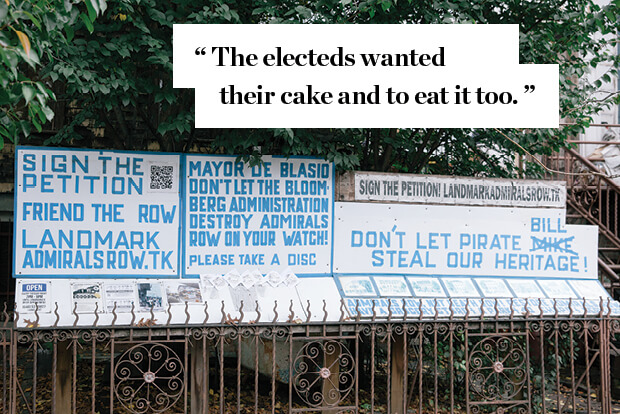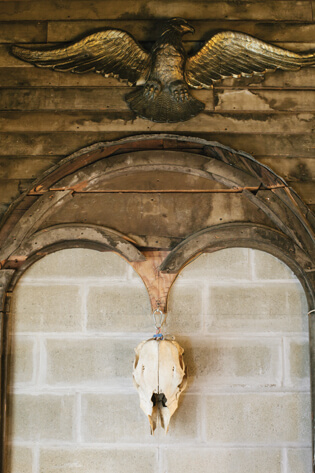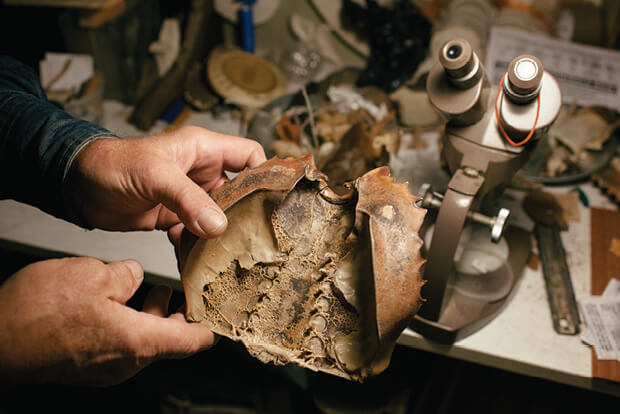The Lost-Cause Preservationist: Inside Brooklyn’s Other Museum

It’s hard to miss the 22-foot slab of particle board mounted on one-by-threes and screwed to the fence outside 109 Hall Street, between Myrtle Avenue and the Brooklyn-Queens Expressway in Wallabout. For one, it is a busy display, equally conspicuous for its size as for the immoderate messaging it’s signal-blasting out to passersby. LANDMARK ADMIRALS ROW, it reads, in block letters formed with blue masking tape. DON’T LET PIRATE MIKE BILL STEAL OUR HERITAGE! There’s a series of lovingly rendered illustrations of Second Empire-style brick mansions. There are printouts and DVDs in paper slipcases pinned to the board. There’s a QR code that will take you to a MoveOn.org petition targeted at the Mayor, the City Council speaker, the Governor, and the chair of the Landmarks Preservation Commission, among other dignitaries.
It’s agitprop of obscure purpose. Who is Pirate Bill? Are the houses in these drawings significant? And just what, exactly, is Admiral’s Row?
Answers to all of these questions come on Tuesday nights when, at 7pm, Scott Witter flicks on a buzzing neon sign and props a piece of slate outside the doorway that says “B.O.M.B. Open” in the same blue tape. B.O.M.B. is Brooklyn’s Other Museum of Brooklyn, a medley of modern pop culture artifacts, found items, junkyard scraps, and other curios assembled with no obvious guiding principle. And Scott Witter is its curator, a self-described “dung beetle, rolling that big pile of shit wherever I go.”
Witter looks like a 67-year-old George Clooney: heavy-lidded eyes, silvery beard, semi-mischievous mien. He speaks with a laconic drawl and offers guests canned Budweisers so cold they’re nearly frozen, before leading them on a tour of his motley museum. There’s the specimen microscope, the thirty puppets found in a dumpster in Dumbo, and the American flag that may have once flown over the Brooklyn Bridge. There’s the assemblage of beach-finds: horseshoe crab shells, weathered glass, a rusted, de-chambered revolver. There’s a collection of porcelain smoking pipes, an icebox given to Witter plastered with 70s softcore porn, and a cast iron eagle salvaged from a firehouse in Downtown Brooklyn. There’s a stained glass window from Dahlman’s Kosher Meat Market and a concrete oculus window that once served as the post office for the former Long Island Rail Road terminal on Flatbush Avenue; both facilities were demolished to make way for the Atlantic Center. And there’s the World War II-era military practice bomb perched above the stairwell, which Witter found in the Utah desert and drove cross-country in his BMW 2002. It’s the museum’s namesake.


The only commonality between these objects is that Witter came upon them–in a dumpster, at the beach, on the sidewalk, or at a construction site–and decided they should be saved. “I’m a collector with almost indiscriminate taste,” he says. “My favorite things to collect are the things I haven’t a clue what they are. If it’s something I think I can fix or use–and I’m a pretty handy guy–I’ll take it. Most people think these things don’t have any value, but it could be a quirk in design, the style of manufacture, the way an object now looks after having been ravished by time.
“Mostly the things I collect are the things other people have discarded,” he adds. “New York is a fascinating place to collect from. It’s incredible what you’ll find.”
Tuesday nights, when the museum is open from 7 to 9pm, are casual affairs, dominated by conversation, billiards, and beer, and attended mostly by a ragtag group of regulars whom Witter has befriended over the years. Friendly chats wend their way through a wide array of topics, but always circle back, eventually, to the topic of Admiral’s Row–the subject to which Witter has devoted the last dozen years of his life.
Admiral’s Row is a string of ten former officers’ quarters, plus a timber shed, on 6.07 acres in the southwest corner of the Brooklyn Navy Yard. The buildings were constructed between 1838 and 1901 and, except for the timber shed, served as homes for high-ranking naval officers until the base was decommissioned in 1966 (the houses remained occupied into the next decade). They are beautiful, haunted, historic buildings, with intricate parapets, elegant cornices, striking mansard roofs and arched windows, now latticed by ivy. The brick timber shed is likely the last-remaining structure of its kind in the United States; Building H is the only one constructed of limestone. During World War II, the officers who lived in these houses oversaw the production of the majority of the American Naval fleet that fought in the war.
In the 1980s, ownership of the Row transferred to the National Guard Bureau, who had no use for it and let the houses fall into disrepair. (The City purchased the rest of the Navy Yard in 1966-67, shortly after the base shut down.) In December 1987, the National Guard was granted authorization to sell the Admiral’s Row strip “at fair market value” (this will be important later on) to the City, under a newly passed piece of federal legislation known as Public Law 100-202.


Although they haven’t been listed on the National Register of Historic Places, the eleven structures comprising Admiral’s Row do meet the eligibility requirements, a fact that the National Guard, the Landmarks Preservation Commission, the New York State Historic Preservation Office, the U.S. Army Corps of Engineers, and dozens of other preservation organizations, local civic groups, and community advocates all agree on. Nevertheless, after Admiral’s Row was finally conveyed to the City in 2011–twenty-four years after the process first began, the last half-dozen of which were rife with public meetings that were “terrible,” to quote one preservationist–only the timber shed and one of the houses were saved. The rest were left unprotected.
In May, the Brooklyn Navy Yard Development Corporation announced that it had accepted a development proposal for the site: Wegmans, the popular, family-owned chain, will build its first New York City store on the property. The 74,000-square-foot store, set to open by the end of 2017, will be about 20,000 square feet larger than the Fairway in Red Hook or the Whole Foods in Gowanus. David Ehrenberg, the President of the BNYDC, said that the Navy Yard selected Wegmans because of its commitment to hiring locally and the affordability of the store’s offerings, according to the New York Times.
As part of the proposal, nine of the 11 Admiral’s Row structures will be razed for a parking lot, while the 5,000-square-foot timber shed and Building B will be retained and restored, at an estimated cost of $7.3 million. Building B is the oldest house and the centerpiece of the row; its architect was possibly Thomas U. Walter, best-known for designing the cast iron dome atop the U.S. Capitol. Its grand ballroom and gardens befit its status as the commandant’s residence.
Oh, and that provision about “fair market value”? According to the BNYDC, the City of New York paid $2 million for the land. It’s impossible to determine fair market value without subjecting the property to the market, of course, but this April, The Real Deal reported that the average price per square foot of land in Brooklyn was $700, which means that 6.07 acres would cost–without factoring in the prime location nor the expenses associated with restoring the two structures–approximately $185 million. It’s fair to say that the City got a plum deal.


“The inspiration for my involvement in the preservation and landmarking of Admiral’s Row is my loathing of politicians who cheat,” Witter says.
Witter moved to Brooklyn in 1966 to study architecture at Pratt, and over the decades has devoted himself to the often-thankless cause of preserving local history in all its weird, ephemeral specificity. Brooklyn’s Other Museum of Brooklyn is a testament to this; so are the dozens of binders containing copies of official documents, newspaper clippings, letters to elected officials, and other documentary evidence of his various preservationist causes, lining the shelves at the museum.
Witter began advocating for Admiral’s Row in 2003, when he came into possession of a 1996 Memorandum of Agreement, later invalidated, between the City and the National Guard. By then he had amassed serious bona fides in the arena of preservationism, most recently as one of three co-chairs of the Coalition to Save Atlantic Terminal. “I had always seen the row as a pristine thing,” he says. His position has been that the City should grant landmark status to the properties, which would give the Landmarks Preservation Commission the final say on whether the houses could be altered in any way. “Even though Building B and the timber shed are being preserved, they’re not being landmarked,” he says. “Which means, in the future, they can be demolished.”
Before the Other Museum, Witter’s most visible demonstration on behalf of landmarking Admiral’s Row was an eloquent protest written out on the protecting fence outside of the houses. He began the message in graffiti, but was arrested promptly and spent 22 hours in jail. So he switched to a different medium: blue masking tape. “Bloomberg taught me to sign without getting busted,” he says. Every day for a couple of months, Witter made the one-mile walk from Hall Street to Admiral’s Row to continue working on the message, which spelled out his desire to see the “STATE ISSUED DEMOLITION” of a “NATIONAL HERITAGE SITE” rescinded. “The cops came, but went away” without arresting him, he says. When he was finished, it took nine crew members to tear down all the tape.
Witter resumed the blue-tape protest at his Steuben Street home, which became the second location of the Other Museum later in 2005. He signed these messages from the “Disgruntled Cow,” a symbolic stand-in for any citizen sick and tired of being milked by Mayor Moo-Moo. At each iteration of the museum, Witter has mounted the same cow skull on a wall, never far from a rat mask that is another symbol for Mayor Bloomberg. “I’m the agent for the Disgruntled Cow,” he says slyly. “She penned the letters, if you will.”


Because of Admiral’s Row’s historical and architectural significance, the National Guard had to go through a public comment and historic review before it could sell the property to the City. This culminated in what’s known as a Section 106 process, referring to an ordinance of National Historic Preservation Act of 1966 that “requires Federal agencies to take into account the effects of their undertakings on historic properties.”
The Section 106 process began in 2005 and concluded six long years later. In addition to neighborhood organizations, like the Fort Greene Association, and community advocates, like Witter, the Landmarks Conservancy, the Municipal Arts Society, and the Historic Districts Council all pleaded with the City to save Admiral’s Row. In spite of that, the final Memorandum of Agreement between the National Guard and the City did not provide any stipulations for preservation. It was only out of good faith that the Navy Yard agreed to maintain and renovate the timber shed and Building B.
“It was the worst public process I’ve ever been involved with, where I really feel that the entities responsible for actually preserving our country’s heritage did not do so,” says Simeon Bankoff, the Executive Director of the Historic Districts Council. “They might’ve followed the letter of the law, but they completely missed the intent. It was appalling.”
One key point of contention was the cost of rehabilitating the houses. A 2008 report commissioned by the Army Corps of Engineers found the structures to be generally “sound, level and plumb,” but the National Guard estimated that repairs would cost $20 million, a number that some preservationists have called inflated, and which only rose during the years in which the houses were left to deteriorate under the Guard’s neglectful ownership, during which the houses were unprotected from the elements.
“They were throwing around numbers, but it’s a question of what are you saving them for?” Bankoff says. “Is it a soup-to-nuts renovation, or are you just saving the structures? It would’ve cost real money. On the other hand, if they had gone in and mothballed the buildings in the 90s, it would’ve cost less.”
None of it really mattered to the Navy Yard Development Corp. In 2007, the Navy Yard’s chief executive, Andrew Kimball, who’s now overseeing the redevelopment at Industry Park, wrote that “neither the city nor the B.N.Y.D.C. are interested in acquiring and developing the site” if the federal government were to require Admiral’s Row to be rebuilt as a condition of transfer. Over the years, Witter and other community advocates wrote beseeching letters to federal figures, including Laura Bush and Barack Obama, to no avail.
The grocery store proved to be another contentious subject. No one doubted that the neighborhood needed a quality, affordable supermarket–something residents of the nearby housing projects had been clamoring for for years. Under the Giuliani administration, the site had undergone a Uniform Land Use Review Procedure so that it could be rezoned to accommodate a jumbo supermarket, and several preservationists think that the City entered the Section 106 process already dug in on placing the store on the Admiral’s Row site.
“It was a fait accompli,” Bankoff says. “The City came up with any justification, and alternative uses were never truly contemplated.”
He continued: “But the supermarket could’ve been built without those buildings being destroyed. It’s being built on empty land, and the row is being demolished for an above-ground parking facility.” In fact, Brent Porter, a Pratt architecture professor, even released a blueprint showing how the site could be redeveloped with a supermarket without knocking down the residences.
The supermarket was used as a wedge, in the form of a fight over food justice, by elected officials. “It got really ugly and racial towards the end,” Bankoff recalls. There were rallies organized by Letitia James, then a City Council member, where people chanted “we want food!” “It was ‘white, gentrifying preservationists in Fort Greene and Clinton Hill are trying to spend money to save these blighted houses when people need fresh food,’” Bankoff says. But two supermarkets on Myrtle Avenue had been knocked down in 2006 for condos, and as the preservationists showed, the City could have built a supermarket and saved the buildings.
“There was nothing in the world to prevent that, except that the Bloomberg and Giuliani administrations had absolutely no interest in taking care of those buildings, and made it very clear–and I assume, to the feds, in private conversation–that they wanted the land delivered unencumbered. It’s that simple.”
One source[a] forwarded me a May, 2011 letter that was sent to the Secretary of the Army and signed by U.S. Senators Kirsten Gillibrand and Charles Schumer, and U.S. Representatives Nydia Velázquez and Ed Towns, in which the signers stated that an “unprecedented consensus” had developed about the site, and asked that money previously set aside for preservation be used instead to offset the purchase price of the property. “The electeds wanted their cake and to eat it too,” the source wrote. “Essentially they wanted to look good for reaching an understanding with the community–which is completely untrue–and then they wanted a discount rate on the land because they were feeling cheated. I stopped caring sometime before this point of utter sophistry.”
The Wegmans announcement was enthusiastically greeted by the press and locals alike in May. It is part of a larger redevelopment of the Admiral’s Row site that is being guided by Steiner Studios, which has its 26-acre campus and headquarters elsewhere in the Navy Yard. The Wegmans itself will be part of a larger building with 126,000 square feet of light industrial space, and Steiner is also developing up to 86,000 square feet of retail, commercial, and office space on the Admiral’s Row acreage.
Steiner’s lease for the site is 97 years—coterminus with the Brooklyn Navy Yard Development Corporation’s lease from the City. They’re actually the third developer the BNYDC has worked with. The first, PA Associates, was fired in 2011 after being linked to a federal bribery investigation involving State Senator Carl Kruger. The second, Blumenfeld Development Group, was removed for failing to bring in a quality, affordable supermarket.


These delays have saved Admiral’s Row from the wrecking ball, so far. But overwhelmingly, the once-loud consensus amongst preservationists has quieted down to a single voice: Witter’s. Everyone else has moved on, but Witter still regularly makes his presence felt at community board meetings, voicing grievances during the public testimony segment and passing out copies of an eight-minute documentary about the Other Museum and Admiral’s Row produced by BRIC TV earlier this year. He’s not always greeted warmly. At a recent meeting of Community Board 2’s Land Use Committee, Witter ran into Robert Perris, CB 2’s District Manager, in the elevator. “I see you’ve got something on your mind,” Perris said dryly, noting Witter’s trademark black cap, on which he’d pinned seven buttons bearing the Admiral’s Row illustrations. “Why let the facts get in the way of a good fight?”
Despite apparent randomness, everything at the Brooklyn’s Other Museum of Brooklyn has a story-—which is to say that every item, from the wired-glass fire cover that lights up to the 1920 Briggs & Stratton Flyer, doubles as a token of Witter’s lifelong impulse to collect, to salvage. Considered as a whole, the collection has an intricate internal coherence, arrived at perhaps more by chance than strategy, and with a tangled web of connections and contradictions that are only completely navigable by Witter himself. He keeps adding to it, too, such that on Tuesday nights, after the regulars have climbed the creaky stairs, it can be somewhat difficult to negotiate the space. Witter is in the process of relocating some archival documents and unsorted “junk” to a house he recently purchased in the Adirondacks, which he’s remodeling. “I’m trying to get this down to museum-quality,” he says.
Meanwhile, a mile away, Admiral’s Row continues its elegant decay. Time is short on the cause for which Brooklyn’s Other Museum of Brooklyn was erected, but if Witter is thinking about that, it doesn’t show. When I asked him about the museum’s raison, he cut me off, saying “it still is to preserve Admiral’s Row.” Then he shifted right into the particulars: “It doesn’t have to be demolition or preservation. My concern is that [the City] is using the Section 106 process as a mandate to tear down Admiral’s Row.
“But it’s not,” he continued. “They should be landmarked.”
You might also like 



















